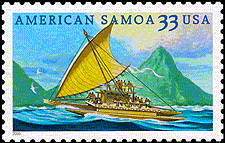

 
|
|
HISTORY SINCE THE ARRIVAL OF EUROPEANS
This picture shows a sail boat similar to the kinds that brought Europeans to the Pacific in the 19th century. Their tall and big masts must have impressed the Samoans that they called their operators Palagi, which could be translated as 'sky bursters'. The missionaries followed not far behind, and thanks to their tireless work, Samoans now are mostly Christians. The missionary contacts were initially made in the the western islands of Samoa and gradually and reluctanly made its way to the Manu'a islands. But once it made its way in and became accepted, it merged into the fa'a Samoa in a way that is uniquely Samoan. The European and American powers in the later part of the 19th century divided the Samoan islands - the western islands, including Savai'i, Upolu and a few other smaller islands were annexed to Germany, with the rest of the islands eastern to the United States of America. Upolu and Savai'i were the largest islands in the Samoa archipelago ideal for very large plantations to supply the needed raw materials for the industrialized nations. American Samoa is strategically located halfway between California and Australia and it has a very safe and protected harbor that is ideal for Naval use. After World War I, Germany lost Western Samoa to Brittan and its colonial possessions, primarily New Zealand. New Zealand administered Western Samoa for most of the first half of the 20th century until Western Samoa became an independent nation is 1962. American Samoa became a U.S. territory in 1900 when the islands of Tutu'ila and Aunu'u were ceded over to the United States. Manu'a was ceded to the United States of America soon after in 1904. About 20 years later, the US congress recognized these signed 'deeds' and so remains this relationship between the United States and American Samoa to this day.
But what about Manu'a during this period? Manu'a is about 80 miles away from Tutu'ila and it doesn't have any of the attractive features that attract foreigners to Upolu and Tutu'ila, such as plenty of land and safe harbor. What it did have however, I believe, was tradition and politics. The Samoans were entranched in the fa'a Samoa - a collective set of cultural, traditional and political norms that govern the Samoans everyday lives. The Manu'a influence in those days was probably due to the strength of the fa'a Samoa that tied all the Samoan islands. A member of Roggewein's expedition, which first sited Samoa (on the eastern islands) in 1722, described the natives in these words: "They are friendly in their speech and courteous in their behavior, with no apparent trace of wildness or savagery. They do not paint themselves, as do the natives of some other islands, but on the lower part of the body they wear artfully woven silk tights or knee breeches. They are altogether the most charming and polite natives we have seen in all of the South Seas." There are several errors in this description, because, I think, they only observed the Samoans from a distance. Then why did he remarked about their speech and behavior? Who knows!
|